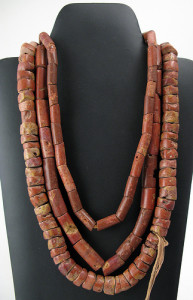Semi-precious African beads can really add class to your jewelry creations. But, as I know too well, being able to invest in such valuable beads isn’t always possible when you’re first starting out. Ever one for a bargain, I began searching for beads with similar aesthetics to semi-precious beads that were a little less expensive – and then I discovered Bauxite!
Bauxite is an aluminium ore, and the main element for aluminium sheeting. In its natural state, it is usually speckled or mottled in appearance, with orange and gray deposits. Colors can range from rust-brown to beautiful sunset hues, like salmon pink. Of course, being resourceful as they are, the people of Ghana have long known the beautiful properties of bauxite. Being a soft mineral, it’s relatively easy to manipulate into cylindrical shapes and tubes – the most common shapes of Bauxite Beads.
Ghanaians wear Bauxite Beads for some of their most important religious rites. At funerals, it’s customary for both the corpse, and the mourners to be adorned with beads for the rather bizarre practice of funeral wailing. Relatives and friends of the deceased unite in chanting “We’re going to chew abo” – loosely translated as “we’re going to bite the dust”. “Abo” means “of dust”, and in most parts of the Krobo, these beads are called “Abo Beads”.
Despite the fact Bauxite Beads are still produced in abundance in Ghana, there are quite a number of ceramic imitations circulating online. So, how do you tell the difference? Simply dampen your beads with a little water and sniff them. Real Bauxite Beads smell like fresh earth!
